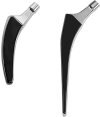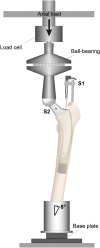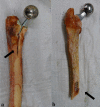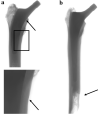Biomechanics of a cemented short stem: a comparative in vitro study regarding primary stability and maximum fracture load
- PMID: 33755800
- PMCID: PMC8437915
- DOI: 10.1007/s00402-021-03843-x
Biomechanics of a cemented short stem: a comparative in vitro study regarding primary stability and maximum fracture load
Abstract
Purpose: In total hip arthroplasty, uncemented short stems have been used more and more frequently in recent years. Especially for short and curved femoral implants, bone-preserving and soft tissue-sparing properties are postulated. However, indication is limited to sufficient bone quality. At present, there are no curved short stems available which are based on cemented fixation.
Methods: In this in vitro study, primary stability and maximum fracture load of a newly developed cemented short-stem implant was evaluated in comparison to an already well-established cemented conventional straight stem using six pairs of human cadaver femurs with minor bone quality. Primary stability, including reversible micromotion and irreversible migration, was assessed in a dynamic material-testing machine. Furthermore, a subsequent load-to-failure test revealed the periprosthetic fracture characteristics.
Results: Reversible and irreversible micromotions showed no statistical difference between the two investigated stems. All short stems fractured under maximum load according to Vancouver type B3, whereas 4 out of 6 conventional stems suffered a periprosthetic fracture according to Vancouver type C. Mean fracture load of the short stems was 3062 N versus 3160 N for the conventional stems (p = 0.84).
Conclusion: Primary stability of the cemented short stem was not negatively influenced compared to the cemented conventional stem and no significant difference in fracture load was observed. However, a clear difference in the fracture pattern has been identified.
Keywords: Biomechanics; Cadaver; Cemented total hip arthroplasty; Fracture pattern; Micromotion; Migration; Primary stability; Short stem.
© 2021. The Author(s).
Conflict of interest statement
KPK reports personal fees and non-financial support from Mathys Ltd. HR reports paid presentations for Smith & Nephew Co. and Mathys Ltd. All the other authors declare, that they have no conflicts of interest.
Figures




Similar articles
-
Biomechanics of a cemented short stem: Standard vs. line-to-line cementation techniques. A biomechanical in-vitro study involving six osteoporotic pairs of human cadaver femurs.Clin Biomech (Bristol). 2018 Feb;52:86-94. doi: 10.1016/j.clinbiomech.2018.01.004. Epub 2018 Jan 31. Clin Biomech (Bristol). 2018. PMID: 29407863
-
Fracture load for periprosthetic femoral fractures in cemented versus uncemented hip stems: an experimental in vitro study.Orthopedics. 2008 Jul;31(7):653. Orthopedics. 2008. PMID: 19292385
-
Periprosthetic proximal femoral fractures in cemented and uncemented stems according to Vancouver classification: observation of a new fracture pattern.J Orthop Surg Res. 2020 Mar 10;15(1):100. doi: 10.1186/s13018-020-01619-4. J Orthop Surg Res. 2020. PMID: 32156300 Free PMC article.
-
Periprosthetic femoral bone loss in total hip arthroplasty: systematic analysis of the effect of stem design.Hip Int. 2017 Feb 21;27(1):26-34. doi: 10.5301/hipint.5000413. Epub 2016 Aug 3. Hip Int. 2017. PMID: 27515762 Review.
-
Causes of failure in periprosthetic fractures of the hip at 1- to 14-year follow-up.Injury. 2014 Dec;45 Suppl 6:S85-92. doi: 10.1016/j.injury.2014.10.029. Epub 2014 Nov 14. Injury. 2014. PMID: 25457325 Review.
Cited by
-
Is it reasonable to shorten the length of cemented stems? A finite element analysis and biomechanical experiment.Front Bioeng Biotechnol. 2023 Nov 17;11:1289985. doi: 10.3389/fbioe.2023.1289985. eCollection 2023. Front Bioeng Biotechnol. 2023. PMID: 38047282 Free PMC article.
-
Does introduction of a cemented polished taper-slip femoral stem reduce early periprosthetic fracture risk with anterior approach total hip arthroplasty? A case-matched study.Arch Orthop Trauma Surg. 2025 Apr 24;145(1):264. doi: 10.1007/s00402-025-05871-3. Arch Orthop Trauma Surg. 2025. PMID: 40274618
-
Stemless reverse shoulder arthroplasty neck shaft angle influences humeral component time-zero fixation and survivorship: a cadaveric biomechanical assessment.JSES Int. 2024 Apr 19;8(4):880-887. doi: 10.1016/j.jseint.2024.04.001. eCollection 2024 Jul. JSES Int. 2024. PMID: 39035638 Free PMC article.
References
-
- The Swedish hip arthroplasty register annual report 2017. https://registercentrum.blob.core.windows.net/shpr/r/Eng_Arsrapport_2017.... Accessed 13 Mar 2021
-
- The Norwegian arthroplasty register annual report 2018. http://nrlweb.ihelse.net/eng/Rapporter/Report2018_english.pdf. Accessed 13 Mar 2021
-
- National Joint Registry (NJR) for England, Wales, Northern Ireland and the Isle of Man 2018 Annual Report. https://www.hqip.org.uk/wp-content/uploads/2018/11/NJR-15th-Annual-Repor.... Accessed 13 Mar 2021
-
- Australian Orthopaedic Association National Joint Registry annual report 2018. https://aoanjrr.sahmri.com/documents/10180/576950/Hip%2C%20Knee%20%26%20.... Accessed 13 Mar 2021
MeSH terms
LinkOut - more resources
Full Text Sources
Other Literature Sources
Medical

